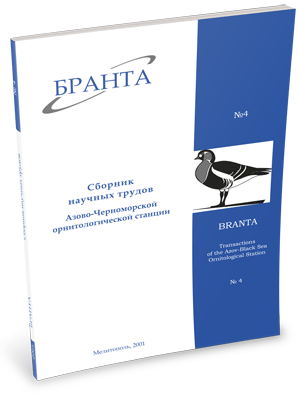
Transactions
of the Azov-Black Sea Ornithological Station



Nesting group of Greylag Goose in the Crimea: the history of formation, parameters and peculiarities.
Kinda V.V., Grinchenko A.B., Beskaravayny M.M..
Data of many years investigations (1983 - 2000) are generalized in the article, regarding to distribution, number and breeding biology of Greylag Goose in the Crimea and Sivash areas of Khersonskaya region. Data about one revealed nest and 44 observed broods were added by verbal communications of other ornithologists, local hunters (2 broods) and game managers. In addition to the original messages, literary sources were analyzed. It gave an opportunity to show a timeline of species invasion in different sites of the Sivash.
Before the early 1970s, Greylag Goose was known in the Crimea as a migratory and wintering species (Kostin, 1983). In October 1963 the North-Crimean Canal begin working, and subsequent many years water-freshening of the Sivash, lowerings and salt lakes of the Sivash area promoted gradual formation of biotopes appropriate for the species. Since 1972 some pairs and small groups of migratory birds occurred regularly in the spring-autumn period on the Lebyazhy islands (Kostin, 1983). Since 1979 to the early 1990s Greylag Goose inhabited all large bays of the Eastern Sivash. Since 1992 it nested on the water bodies of the eastern part of Kerchensky peninsula. Since the middle 1996 three breeding sites were found on the Western Sivash. The breeding sites are shown in the figure.
Data on breeding biology were gathered on Kerchensky peninsula, mostly in Astaninskie plavni. Total breeding number reached probably 35 - 40 pairs, but by 2000 it decreased by one third. The number of non-breeding birds ranges within 200 - 300 birds.
Terms of breeding are usual for the southern region of Ukraine. Number of nestlings in broods ranges from 1 to 8. Frequency of broods observations in 1992 -1995 was the following: a brood with one nestling -1(2.2%), two nestlings- 7 (15.2%), 3 nestlings - 6 (13.0%), 4 nestlings -1 4 (30.4%), 5 nestlings -1 1 (23.9%), 6 nestlings -3 (6.5%), 7 nestlings-1 (2.2%), 8 nestlings-3 (6.5%). Mean number of nestlings (30-35 days in age) of one successfully breeding pair varies between years. On Kerchensky peninsula in 1992 this index was (n = l l) - 5.2; in 1993 (n=10) - 3.5; in 1994 (n=10) - 3.8; in 1995 (n=9) - 4.3; average number during 4 years (n=40) reached 4.2. In general for this group of birds mean breeding success reached 4.4 nestlings in one pair. This index is a little lower than in Priazovye, the Danube area, flood-lands of the Orel and the Samara rivers - 5.1 - 5.8 (Lysenko, 1991).
In some points of Central and Eastern Sivash summer gatherings of Greylag Goose form in the first half of August. In the second half of 1980s there were 300 - 500 individuals, till the middle 1990s - 2-3 thousand (our data). During August 6 - 17 there were counted 6.2 thousand, and according to estimated data the number in that period may reached 6.5-8 thousand (Chernichko et al.,2001). Obviously, these gatherings are formed on the account of birds which migrated from surrounding southern Ukraine areas to the places with more favourable shelter and feeding conditions.
Greylag Goose breeding in the Crimea became possible after building of the North-CrimeanCanal and consequent development of meliorative agriculture and rice fields in the Sivash area and in the eastern part of Kerchensky peninsula. As a result there formed such biotopes which had not been in the region before. And then they were inhabited by this species.
Long-term dynamics of the spatial distribution and number of Greylag Goose nesting group is determined by the formation of the appropriate biotopes in different Sivash sites and water bodies of Kerchensky peninsula (first steps of invasion) and the rate of succession change. Reed-overgrowing of water bodies and coastal areas leads to the reduction in the area of nesting and breeding biotopes; decrease in the number of breeding pairs and increase in the number of single birds. For qualitative improvement of the areas certain biotechnical measures were proposed to carry out every year.
Read the paper in a PDF file